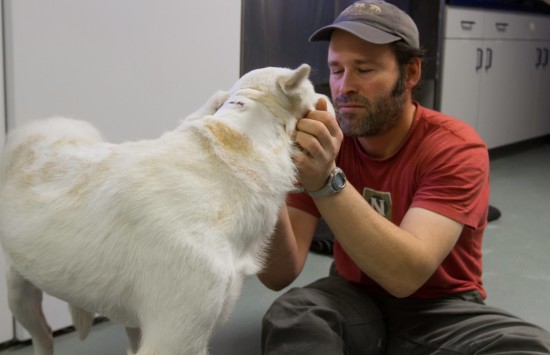
NHA Expedition Leader Brad Josephs shares a warm moment with the injured dog he and his group helped rescue in Churchill, Manitoba.
Dogs in the office at Nat Hab’s Colorado headquarters are nothing new, since our dog-friendly policy has been a long-standing feature. But a few days ago we welcomed a very special canine visitor – one whose taxing journey from near-death on the tundra outside Churchill, Manitoba to a loving new home near Denver would never have happened had it not been for the big-hearted response of Expedition Leader Brad Josephs and his group of polar bear travelers.

Expedition Leader Justin Gibson with Ursula – now Gypsy – at Nat Hab’s Colorado head office following the long drive from Churchill. Photo: Wendy Redal
This friendly white husky mix showed few signs of the trauma that nearly cost her her life just a few weeks earlier. She had just arrived in Boulder with another Expedition Leader, Justin Gibson, who drove NHA’s Sprinter mini bus on the 800-mile trip back from Winnipeg following the end of polar bear season.
It was a happy ending for the young dog’s saga, which could have turned out far differently were it not for Brad’s initiative – and the presence in his group of Dr. Suzanne “Sam” Johnson, an emergency room trauma surgeon who figured she could work on a dog as readily as a human.
On Nov. 1, as the group was headed back into Churchill after a day on the tundra observing polar bears, bus driver Mike Buffi spotted the injured dog limping along the side of the road. “At first he thought, ‘Oh my, is that a wolf?’” said Josephs. Brad hopped out to take a closer look.
“The dog came up to me with a look that said, ‘Please help me,’ he said, and he asked his group if they would be okay with taking the dog back to town to seek help for her – it was apparent, given the severity of a large gash in her neck, along with an injured leg, that she would be unlikely to survive much longer in the harsh Arctic weather conditions.
Without hesitation, the rescue mission commenced. Josephs patted the steps to invite the dog in, and she managed to pull herself up. Yet she could hardly get comfortable. The wound in her neck – a long horizontal slice that went all the way to the bone – appeared to have been made by her collar, perhaps the result of having been dragged behind a vehicle. Between the damage to the left side of neck and a likely broken bone in her right leg, the dog could barely lie down, though she finally curled up in the front while Josephs stroked her fur.
He decided to christen her “Ursula,” a diminutive of the Latin ursa, meaning bear. And with her creamy white color, she was a bit evocative of a polar bear cub, given her environs.
Ursula’s troubles were hardly over, however. Churchill, a small town of 800 on Hudson Bay that’s inaccessible by road, has no veterinarian. While a vet will periodically fly in to offer vaccinations and routine care, in an emergency situation “you are on your own,” said Josephs.
Trying to assess the resources available, Josephs enlisted Churchill Mayor Mike Spence, whom they found outside his house working on his truck. They drove to the town complex to seek additional help. Somewhere in the midst of those conversations, a light went off for Dr. Johnson, and she told Brad, “I can sew this dog up, I just need supplies.”
Patricia Kandiurin, municipal support officer for the town of Churchill, knew just who to call: local dog musher Dan DiMuzio, who was also a paramedic. “He told us he could get the materials we needed,” said Josephs, and “he figured out where we were going to go.” They drove to the public works building on the edge of town where a cement block room held four animal cages and a table. Used as a sort of temporary dog pound, the spartan room would soon become a makeshift veterinary surgery center.

Dr. Suzanne “Sam” Johnson shares a tender moment with her patient before stitching up the dog’s badly injured neck. Photo copyright: Brad Josephs
Buffi returned the group to their hotel, and the OR team got to work. Lacking a proper splint for Ursula’s damaged leg, they fashioned one out of #2 pencils and duct tape. Then it was time to sew up the gaping wound in her neck. Since there was no anesthetic, they would have to do the best they could, knowing she would experience substantial pain. They gave her a Valium and some antibiotics, and Dan put a bandage around her mouth as a muzzle. He held her head and Brad held her back legs while Dr. Sam stitched.
It was an ordeal, to say the least. Dr. Sam had to trim away singed hair and burned, dead flesh from the neck wound after the partially melted collar was removed. It was clear the dog had not been attacked by another animal, said Josephs, citing the clean slice of the collar into her neck and rash marks on her skin that may have been caused by friction from dragging. Continuing her intricate work, Dr. Sam stimulated bleeding for antiseptic effect and separated the skin from the fascia with scissors in order to knit the edges of the dog’s outer skin back together. Yet as Brad leaned in to hold Ursula’s belly down, she sniffed his face and licked his cheek.
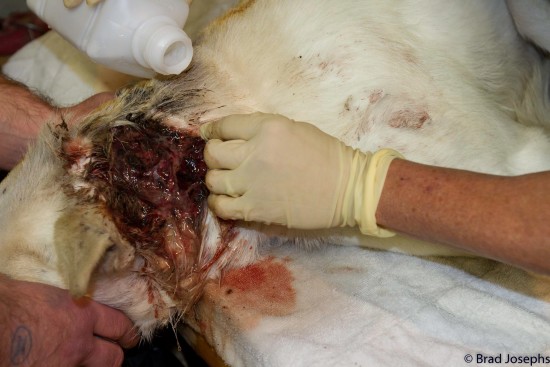
This graphic image reveals how bad Ursula/Gypsy’s injuries were – her collar had cut her flesh all the way to the bone. Photo: Brad Josephs

Dr. Sam’s handiwork closed up the wound until Ursula could receive proper veterinary care in Winnipeg. Photo: Brad Josephs
The whole procedure took nearly an hour. When it was over, Ursula’s rescuers made a little bed in her cage with hay and began to feed her. It was evident she was badly malnourished. In the meantime, town officials called all the local mushers, but no one could identify her.
By this point, it seemed evident that this sweet-natured dog would survive. But her happy-ending story was just beginning. And it was one that had already touched those Nat Hab travelers who were part of her rescue mission. Vincent Tipaldo of Redondo Beach, Calif., was among those who found the experience moving:
“Having kind-hearted Brad, a benevolent bus driver and a fellow tour member who was an emergency room doctor all in one place driving exactly where Ursula was disoriented, in shock and desperately and aimlessly walking along the road was an extraordinary life event I will hold deeply in my heart. That she was so trusting of us to get in the bus and lie down after what apparently was a violent experience at the hands of a human was amazing.”
Tipaldo and his fellow travelers were also impressed with the way town leaders came to the aid of the victim, including “the mayor of Churchill who escorted us to the hospital and rallied people in town who could assist our doctor in immediate emergency surgery.”
Though Dr. Sam’s emergency work saved Ursula’s life, the dog needed thorough veterinary attention. That lay more than 600 miles away by air in Manitoba’s largest city, Winnipeg. Fortunately, the plane that Nat Hab charters each polar bear season provided the means to transport the dog to necessary care.
“She flew in the cabin behind the seats,” Josephs said. “I could pet her, let her walk around a bit on the plane.” He also gave her a “super gourmet sausage from Gypsy’s,” a restaurant in Churchill, for a well-deserved travel treat.
“Natural Habitat was magnificent in allowing Ursula on our charter flight to Winnipeg the very next afternoon where a veterinarian from a rescue society was waiting at the airport for her. All of it is beyond words,” said Tipaldo, describing the saga he and his fellow travelers were part of.
The vet from Tuxedo Animal Hospital met the plane on arrival, and with the aid of a staff member loaded Ursula into a pickup and drove her to the clinic where “she got real surgery,” said Josephs. “They undid the stitches and re-did them and cleaned her up totally,” as well as spayed her. Dr. Sam even came over and assisted with the surgery. Josephs said she had previously passed a hat around the group for donations to cover the dog’s care, and she presented a couple hundred dollars to the clinic.
At this point, the dog was also being called “Cali,” so dubbed by Kandiurin, who was coordinating the case, in honor of Dr. Sam’s home state of California. But Colorado would soon enter into the dog’s future, as Corbin Hawkins, a Nat Hab contract employee, stepped forward to offer her a permanent home.
Hawkins, who works for Nat Hab in Winnipeg during polar bear season, wanted to take the dog back to his home in Lakewood, Colorado, as soon as she was well enough to travel. And that’s when the next leg of her journey commenced, the long road trip with Justin, with a stopover at the office for her many admirers to greet her in person.
By this time, Ursula/Cali’s name had morphed again to “Gypsy,” which Hawkins called her after her checkered route from the northern tundra to Manitoba’s capital and southward to her new home on the edge of the Rocky Mountains. All the tender loving care Gypsy received has worked its magic: She is recovering beautifully as she settles happily into her new home.
Says Hawkins, “Gypsy is doing great! She is such a goofball. She has to sniff everything and loves to jump up and see what’s happening on the kitchen counter. Gypsy and Kali, my other dog, are learning to share their space and doing well at it… She is a smart dog and learning fast!”
Over Thanksgiving, less than a month after her rescue, Gypsy joined Hawkins on a snowshoeing trip near Breckenridge, Colo., reveling in the snow and sunshine.
Gypsy’s story is one that reminds us of the healing power of love. Alone on the edge of the tundra in pain and hours from death a few short weeks ago, Gypsy today is delighting in life, thanks to a team of caring individuals whose hearts were touched by a gentle white dog with a fierce will to live.
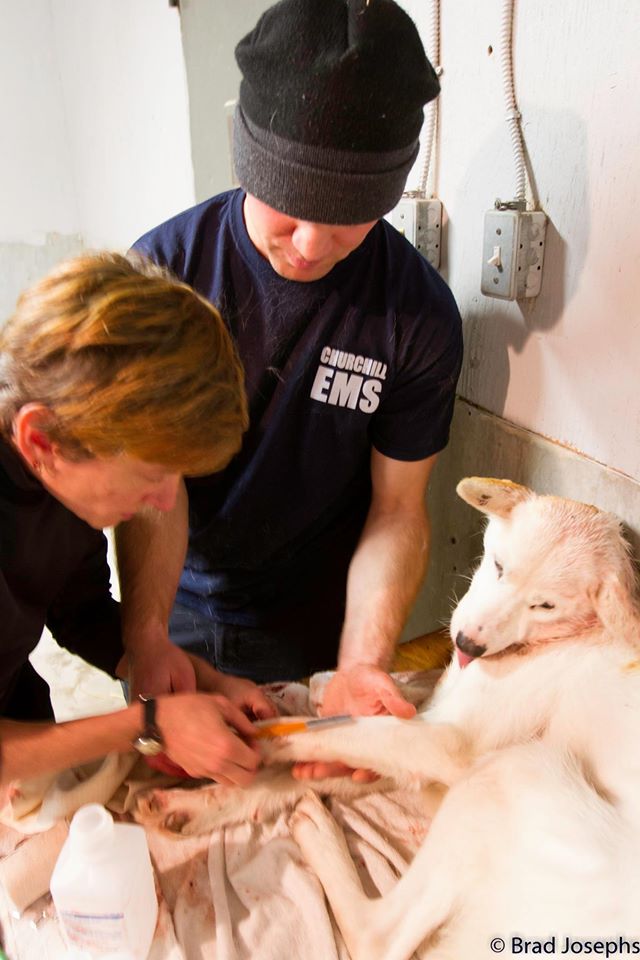 “Compassion for animals is intimately connected with goodness of character.” – Arthur Schopenhauer, German philosopher
“Compassion for animals is intimately connected with goodness of character.” – Arthur Schopenhauer, German philosopher
On the left: Dr. Sam Johnson and paramedic Dan DiMuzio work to splint their rescued patient’s injured leg. Photo copyright: Brad Josephs

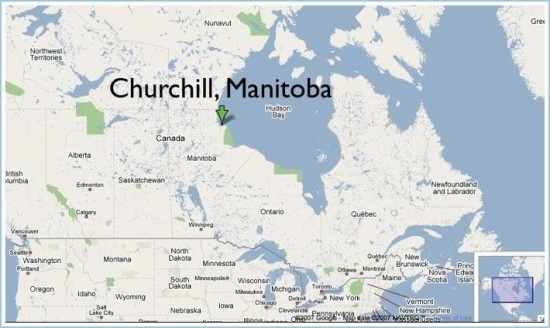

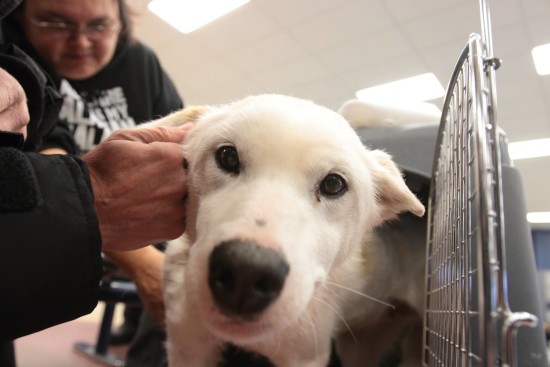

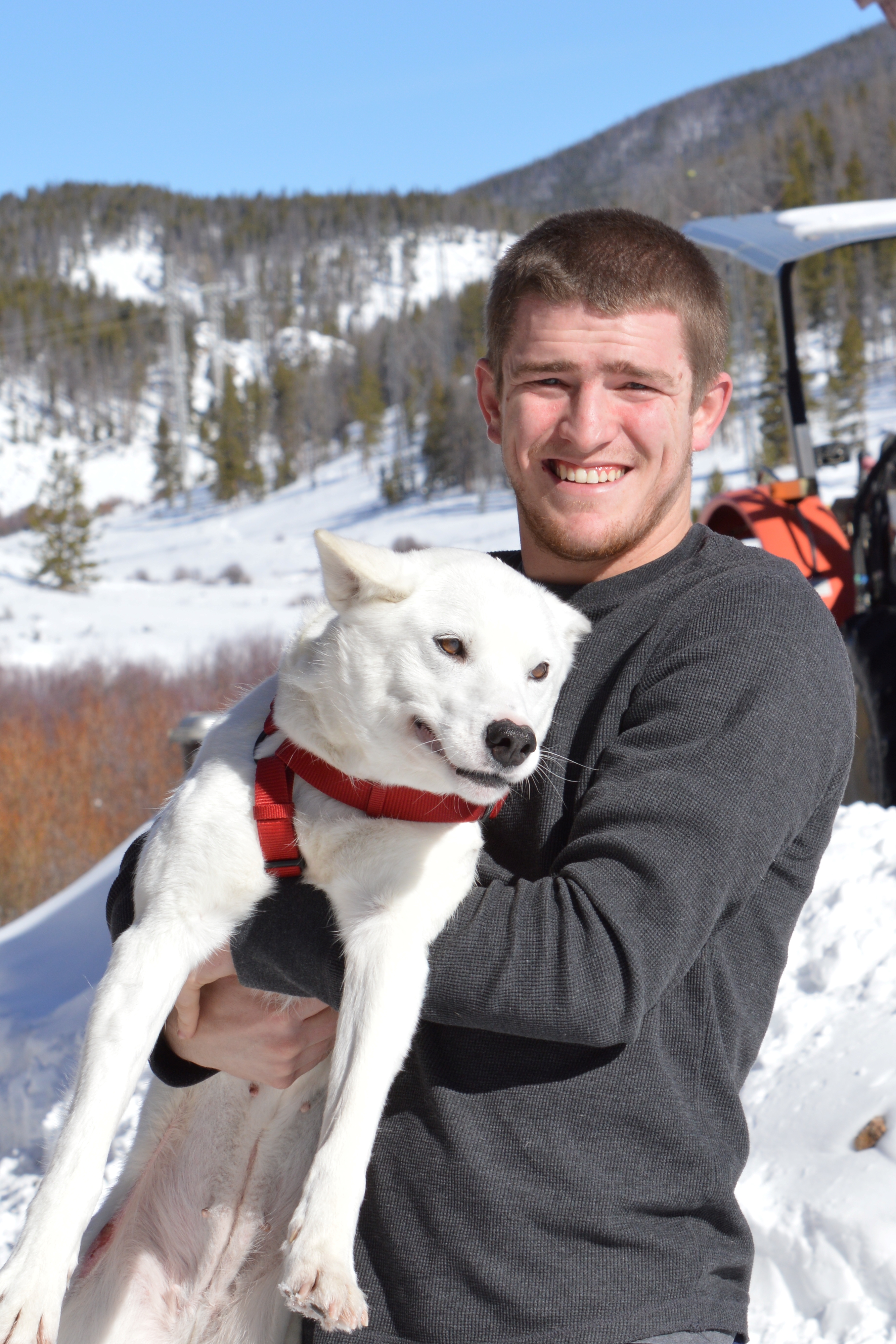



























Thank you for the complete story on Gypsy. I was with another Nat Hab group on that plane with her from Churchill to Winnipeg. This ending just put icing on the cake. The trip that went beyond anything I had dreamed.
I t doesn`t surprise me how everyone worked so well together, in rescuing this dog!! All involved are awesome people & I`m sure would do it again in a heart beat!! I am so glad for such an awesome outcome & great big kudos to all !!!Good on you all !!